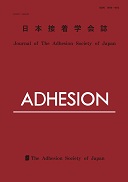All issues

Volume 36, Issue 12
Displaying 1-5 of 5 articles from this issue
- |<
- <
- 1
- >
- >|
Review
-
Mitsuhiko NAKAZAWA2000Volume 36Issue 12 Pages 507-512
Published: December 01, 2000
Released on J-STAGE: April 30, 2015
JOURNAL FREE ACCESSDownload PDF (1868K)
Review
-
Yoshinobu MANDAI2000Volume 36Issue 12 Pages 500-506
Published: December 01, 2000
Released on J-STAGE: April 30, 2015
JOURNAL FREE ACCESSDownload PDF (2545K)
Review
-
Katsutoshi NAGAI2000Volume 36Issue 12 Pages 494-499
Published: December 01, 2000
Released on J-STAGE: April 30, 2015
JOURNAL FREE ACCESSDownload PDF (2048K)
Original Paper
-
Toshio OGAWA, Takao SONOGASHIRA, Satoshi OSAWA2000Volume 36Issue 12 Pages 486-493
Published: December 01, 2000
Released on J-STAGE: April 30, 2015
JOURNAL FREE ACCESSLow surface free energy of the polymer surface leads to water repellency and low frictionalcoefficient. Then, the surface modification was carried out using several fluorination agents formodified polyethylene surface, which was treated in advance by corona discharge method.Thecontact angle of water increased by fluorination and reached to 106.7 using fluorinated silanecoupling agent. The surface free energy was 13.8mJ/m2, and is almost equal to that of polytetrafluoroethylene. Further, it was proven that the reduction of the frictional coefficient was possible by fluorination. These effects were more effective in the fluorination agent having the completely fluorinated end group.View full abstractDownload PDF (2221K)
Original Paper
-
Hiroo MIYAIRI, Zheng Gang, Masahiro NAGAI2000Volume 36Issue 12 Pages 480-485
Published: December 01, 2000
Released on J-STAGE: April 30, 2015
JOURNAL FREE ACCESSComposite resin for dental use plays an important role as tooth restorative resin with in the severe oral environments. The composite resin, which is filled on occlusal surface of a molar tooth, requires high compressive strength and superior wear resistance, and strongly requires the superior adhesion to tooth substance and the sealing performance, in order to stand up to daily masticatory forces. So a lot of studies on adhesive strength of composite resin have been reported, but an adhesive property by impact testing has not been investigated to date. Afterfilled composite resin, its bonding agent existing in organization of tooth is formed as resin tags (length:5-100m) in enamel prism and dentinal tubule which run in direction of lower part inconsiderably toward a tooth axis. But, reports of investigating on effect of the resin tags on adhesive strength have apparently not been published to date. Inthisstudy, effect of such the resin tags with two different directions to impact forces, such as impact directions to tooth rootand tooth edge, on shear impact strength was examined using enamel and dentine of a bovine tooth as adherend, by using Izod impact testing. Asaresult, it be came clear that shear impact strength to enemel in case of impact direction to tooth rootshowed remarkably higher value comparin with that of another impact direction because of effect of resin tags with two impact directions. In case of dentin for adherend, the effect of such resin tags was not recognized.View full abstractDownload PDF (1905K)
- |<
- <
- 1
- >
- >|